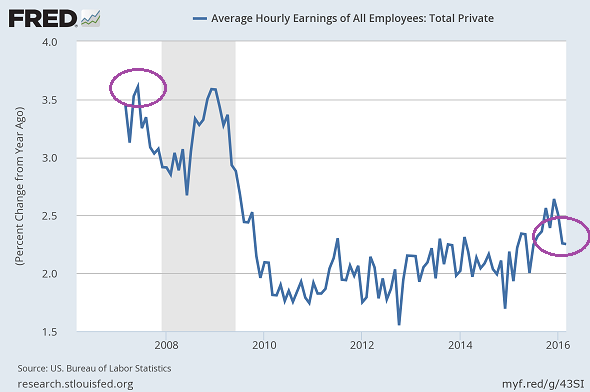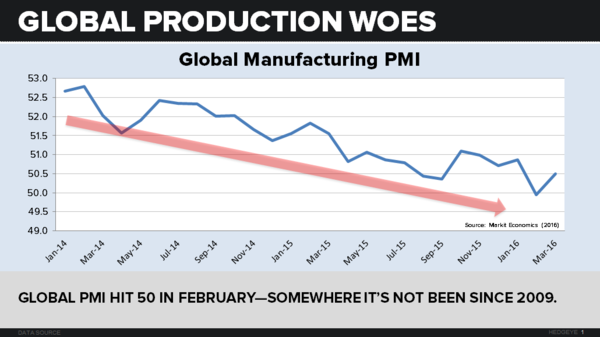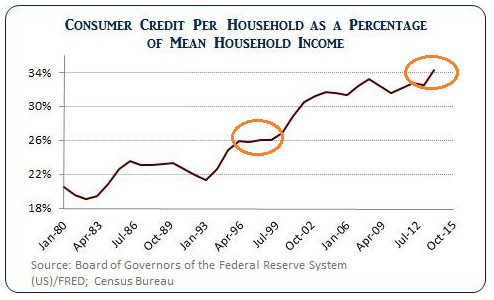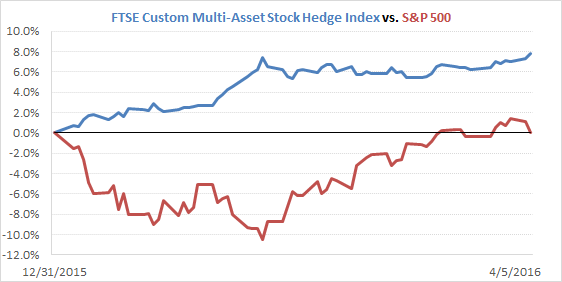Is the U.S. economy really in great shape? The U.S. Federal Reserve does not seem to think so.
They started the year with an intention of raising the overnight lending rate four times – from 0.25% to 1.25%. In March, they announced that it would more likely be a mere two. And yesterday, the Atlanta Fed downgraded its Q1 estimate for gross domestic product (GDP) to a new low for the year (0.4%).

Granted, GDP for the fourth quarter of 2015 came in at a better-than-expected 1.4% after its third revision. However, that is significantly lower than the average economic performance since 2009 of 2.1%.
And then there’s Gross Domestic Income (GDI). This measure looks at the income earned while producing goods and services (as opposed to measuring them on expenditures). GDI finished Q4 2015 at a sub-standard 0.9%, confirming widespread weakness. (Note: Theoretically, GDP and GDI should match one another, but they deviate due to different methods of calculation.)
If one ignores the average rate of U.S. expansion in history, disregards the current 6-month slowdown in GDP/GDI, and overlooks the Federal Reserve’s emergency measures for monetary policy accommodation, one might applaud the economic “progress” made between 2009 and 2016. Conversely, realistic observers know that things are not that rosy.
For example, U.S. government debt has swelled from roughly $11 trillion to $19 trillion. That’s a great deal of stimulus to keep the economy afloat. The Fed’s balance sheet has bloated from $800 billion to nearly $5 trillion. That’s an incredible amount of stimulus designed to bolster borrowing activity. Yet the big bang from the $12 trillion-plus injection is an economy that can barely hold its head above water.
Apologists point to other data points that suggest the U.S. economy is dandy. “Robust job growth,” they say. Of course, they neglect to mention that low-quality positions in leisure, hospitality, retail and customer service account for most of the gains, whereas high-paying positions, particularly in manufacturing, continue to evaporate. That data shows up in average hourly earnings, where stagnation in wages are indicative of a shift toward lower-paying jobs with fewer hours.

There’s more. Approximately 14 million jobs have been created since the end of the financial crisis in 2009. Sounds impressive, right? Unfortunately, the size of the labor force grew by roughly 16 million potential participants in the same seven-year period. Now we have 94 million working-aged Americans (16-64) who are not even counted in the labor force – those who have no job and who are not currently looking for a job.

Granted, many younger folks are going to school and many older folks have retired. Nevertheless, the bulk of these 94 million individuals (16-64) simply believe that they do not have viable employment options.
“But Gary,” you argue. “The economy here would be doing okay if it weren’t for the problems with overseas economies.” That may very well be true.
On the other hand, this possibility only clarifies the fact that we live in a world that is more interconnected than ever before. Most of the world’s economies still depend on their product exports. It follows that when the world’s manufacturing is free-falling, the U.S. economy is going to feel it.

“We are a consumption-based society with resilient consumers,” you respond. Unfortunately, the idea that resilient U.S. consumers can overcome global manufacturer woes is as erroneous as the notion that U.S. companies can escape the negative impact that weak currencies have had on corporate profits. They can’t and they aren’t.
Global manufacturing woes have been adversely affecting the quality of the jobs that people have stateside. In fact, American consumer resilience is little more than “code” for acknowledging that we increase our debts at a much faster clip than we increase our take-home pay.
Specifically, at the turn of the century, household consumer credit as a percent of average income had risen to 26%. Today? This percentage has jumped to 34%. Over-leveraged households imply that there will be some constraints on consumption, contributing to the overall weakness in the current economic backdrop.

Think that the economic weakness is not going to have an impact on risk taking? Think again. Even the U.S. central bank’s about-face on rate hikes in 2016 – even the 14% surge in the S&P 500 SPDR Trust (NYSE:SPY) off of its mid-February lows – may not encourage as much “risk on” activity as many investors hope for.
Consider the year-to-date performance of the FTSE Custom Multi-Asset Stock Hedge Index (MASH) as it relates to the S&P 500. MASH, with “risk-off” assets such as the SPDR Gold Trust (NYSE:GLD), Currency Shares Yen Trust (NYSE:FXY) as well as PIMCO 25+Year Zero Coupon (NYSE:ZROZ) and iShares National Muni Bond (NYSE:MUB) are collectively outperforming the stock benchmark with significantly less volatility.

Disclosure: Gary Gordon, MS, CFP is the president of Pacific Park Financial, Inc., a Registered Investment Adviser with the SEC. Gary Gordon, Pacific Park Financial, Inc, and/or its clients may hold positions in the ETFs, mutual funds, and/or any investment asset mentioned above. The commentary does not constitute individualized investment advice. The opinions offered herein are not personalized recommendations to buy, sell or hold securities. At times, issuers of exchange-traded products compensate Pacific Park Financial, Inc. or its subsidiaries for advertising at the ETF Expert web site. ETF Expert content is created independently of any advertising relationships.
